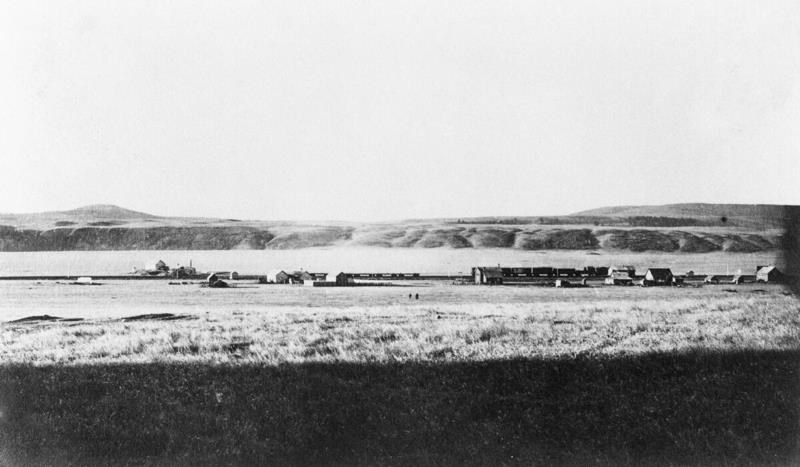Drivers miffed at today’s traffic congestion should be thankful they didn’t have to navigate the main road in and out of Cochrane back in the day.
Travellers going west might have been surprised one day to see a team of draught horses pulling a church on logs towards town.
On another day going east, they would have been stopped by a herd of pigs grunting their way down the hill, keeping alive the traditional mode of transport the Glenbow farmer brought with him from Ireland – the road belongs to the four-leggers as well, after all.
Those are just two traffic jam examples from Cochrane’s colourful past as the 20th century approached.
From ex-Mountie turned bootlegger and squatter Dave Cochrane (not the town’s namesake) to prankster Glenbow maid Jenny Johnson – who liked to over-warm her governess’s chamber pot – the human characters who helped create Cochrane’s early history were often colourful in their own right.
Newcomers and old-timers alike should find these and other stories of interest in the Cochrane Historical & Archival Preservation Society’s (CHAPS) upcoming Cochrane’s Hidden History series.
The three-part series of presentations by historians and archaeologists familiar with the terrain kicks off April 22 with The Ghosts of Mitford.
Gordon Davies of CHAPs said the series is really about ‘Cochrane and area’ because a lot of the hidden history took place before Cochrane even existed.
He hopes people find the stories as interesting as he does.
“It’d be great to see some of the newer people in town come,” he said. “Even the old-timers really don’t know the history of Mitford.
“There’s something for everybody, really.”
In 1885, T.B.H. Cochrane and his wife Adela exchanged their lease of 55,000 acres (223 square kilometres) near High River for one just west of present-day Cochrane, at what became Mitford.
Cochrane was no relation to Senator Matthew Henry Cochrane, the man who established the Cochrane Ranche in 1881. The Canadian Pacific Railway named the town of Cochrane after the senator. Few people made it their home at first, despite the surrounding ranching population.
Established in 1886, Mitford supported a sawmill and later a coal mine.
“At that time the Canadian Pacific Railway (CPR) stopped in Mitford, so it developed into a fairly large community, with a post office, a store. Cochrane meanwhile was merely a townsite, with nothing on it,” Davies said.
Once Mitford failed however, Cochrane began to grow.
But Davies said the story of Mitford is interesting because it’s a story of a certain kind of man. T.B.H. Cochrane was a remittance man.
“It was a term that was applied to the sons of wealthy families in Britain, and very often they were sons that sort of embarrassed the family, so they would ship them off to the colonies, give them some money, in the hope they succeeded here,” he said.
“Apparently, Lady Adela was associated with the court of Queen Victoria, so they had some money, and they decided to build a town,” he said.
Cochrane associated himself with the Calgary Lumber Company and built a sawmill, feeding it from the vast amount of lumber on his lease.
However, the success of the sawmill was limited. Most of the good quality fir to be found in the area was never sold, instead ironically being used to construct a railway designed to transport the lumber to market.
Although the CPR approached the mill from the east, tension built between Cochrane and the railway, as the engineers did not like stopping at the mill due to the steep grades nearby.
In 1888, a coal mine began operation in the area, with the distinct advantage of having the sawmill's railway nearby to transport the coal to market.
But by 1890, it became obvious that both operations were doomed to fail.
In an effort to save the town, Cochrane established a brickyard using material found just north of Mitford. Three years later, that operation was also closed, due to the inferior quality of its product.
The writing was on the wall for the Cochranes’ little dream town.
“The Cochranes used to go home every winter to England. I think they only spent one winter in Mitford, and eventually they returned home and left town – abandoned it, I guess,” Davies said.
After the closing of the brickyard, the town fell into decline before it was abandoned in 1898. What was left of the townsfolk moved into Cochrane.
Mitford is now a ghost town, while Cochrane is Alberta’s fastest growing community, with a population north of 34,000 residents.
Davies said it could be a bit of a learning curve for wealthy British transplants.
He recalls his parents talking about remittance men. It wasn’t the most complimentary term.
“They often came with an attitude, that they knew everything that was going on here. I remember mom and dad saying often, on the ranches, they’d put them on the wildest broncs they had in the corral,” he said. “It was pretty rough here.”
Davies said people will be interested in hearing more details of the life of Lady Adela.
The second in the series will be May 13, entitled See Where Cochrane’s History is Being Pieced Together. That talk will be presented by Sean Pickering, an archaeologist who will share what he has learned from digs in the area going back to pre-contact days.
The little town of Glenbow will be the subject of the third presentation in the series on June 3, hosted by archaeologist Shari Peyerl, entitled, If These Walls Could Talk. Peyerl recently published a book chronicling the history of the Glenbow ranch and former town.
The Ghosts of Mitford on April 22 kicks things off at Frank Wills Memorial Hall at 7 p.m. Admission is free.




